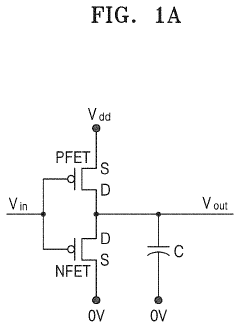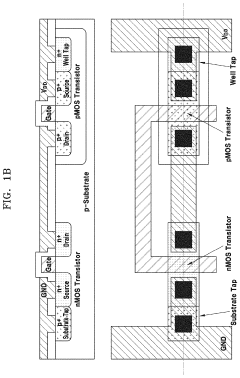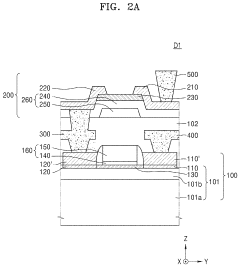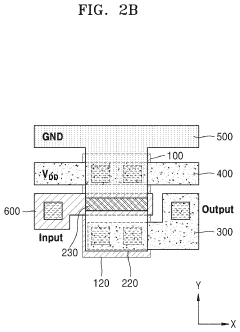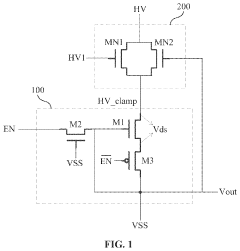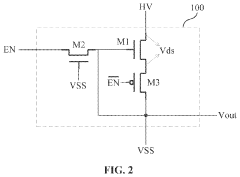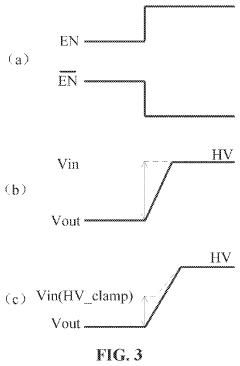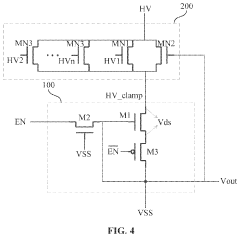Evaluating CMOS Battery Role in Modern Smart Watches
JUL 22, 20259 MIN READ
Generate Your Research Report Instantly with AI Agent
Patsnap Eureka helps you evaluate technical feasibility & market potential.
CMOS Battery Evolution
The evolution of CMOS batteries in modern smart watches represents a significant technological journey, reflecting the broader trends in miniaturization and power efficiency in consumer electronics. Initially, CMOS batteries were primarily used in personal computers to maintain basic system settings and real-time clock functions. As wearable technology emerged, particularly smart watches, the role of CMOS batteries expanded and adapted to meet new challenges.
In the early stages of smart watch development, CMOS batteries were often separate components, similar to their counterparts in desktop computers. These batteries were responsible for maintaining critical low-power functions when the main battery was depleted. However, as smart watches became more sophisticated and compact, the integration of CMOS functionality into the main system architecture became a priority.
The transition from separate CMOS batteries to integrated solutions marked a crucial point in smart watch design. Manufacturers began incorporating CMOS functions into the main system-on-chip (SoC) designs, utilizing small capacitors or the main battery to maintain essential data. This shift allowed for more efficient use of limited space within the watch casing and reduced the overall component count.
As smart watches evolved to include more advanced features such as health monitoring, GPS tracking, and always-on displays, the power management requirements became increasingly complex. The role of CMOS-like functionality expanded to include managing various low-power states and quick wake-up capabilities. This evolution necessitated more sophisticated power management integrated circuits (PMICs) that could handle the diverse power needs of modern smart watches.
Recent advancements in CMOS battery technology for smart watches have focused on improving energy density and reducing power consumption. Manufacturers have explored novel materials and designs to create ultra-low-power CMOS circuits that can maintain critical functions for extended periods, even when the main battery is completely drained. These innovations have contributed to the development of smart watches with longer battery life and more reliable standby capabilities.
The integration of energy harvesting technologies, such as solar cells or kinetic energy converters, has further transformed the role of CMOS batteries in smart watches. These systems can replenish the energy used for CMOS functions, potentially eliminating the need for separate CMOS batteries altogether in some designs. This convergence of technologies represents the cutting edge of power management in wearable devices, promising even more efficient and sustainable smart watch designs in the future.
In the early stages of smart watch development, CMOS batteries were often separate components, similar to their counterparts in desktop computers. These batteries were responsible for maintaining critical low-power functions when the main battery was depleted. However, as smart watches became more sophisticated and compact, the integration of CMOS functionality into the main system architecture became a priority.
The transition from separate CMOS batteries to integrated solutions marked a crucial point in smart watch design. Manufacturers began incorporating CMOS functions into the main system-on-chip (SoC) designs, utilizing small capacitors or the main battery to maintain essential data. This shift allowed for more efficient use of limited space within the watch casing and reduced the overall component count.
As smart watches evolved to include more advanced features such as health monitoring, GPS tracking, and always-on displays, the power management requirements became increasingly complex. The role of CMOS-like functionality expanded to include managing various low-power states and quick wake-up capabilities. This evolution necessitated more sophisticated power management integrated circuits (PMICs) that could handle the diverse power needs of modern smart watches.
Recent advancements in CMOS battery technology for smart watches have focused on improving energy density and reducing power consumption. Manufacturers have explored novel materials and designs to create ultra-low-power CMOS circuits that can maintain critical functions for extended periods, even when the main battery is completely drained. These innovations have contributed to the development of smart watches with longer battery life and more reliable standby capabilities.
The integration of energy harvesting technologies, such as solar cells or kinetic energy converters, has further transformed the role of CMOS batteries in smart watches. These systems can replenish the energy used for CMOS functions, potentially eliminating the need for separate CMOS batteries altogether in some designs. This convergence of technologies represents the cutting edge of power management in wearable devices, promising even more efficient and sustainable smart watch designs in the future.
Smartwatch Market Trends
The smartwatch market has experienced significant growth and transformation in recent years, driven by advancements in technology and changing consumer preferences. This wearable technology segment has evolved from basic fitness trackers to sophisticated multi-functional devices that seamlessly integrate with smartphones and other smart devices.
Market data indicates a robust expansion of the smartwatch industry, with global shipments reaching record levels. The market is characterized by intense competition among established tech giants and innovative startups, each vying for market share through product differentiation and technological advancements. Key players in this space include Apple, Samsung, Garmin, and Fitbit, among others.
Consumer demand for smartwatches has been fueled by increasing health consciousness and the desire for convenient, always-connected devices. The COVID-19 pandemic has further accelerated this trend, with more people focusing on personal health monitoring and remote fitness tracking. As a result, health and fitness features have become central to smartwatch offerings, including heart rate monitoring, sleep tracking, and even blood oxygen level measurements.
Another notable trend is the growing integration of smartwatches with broader ecosystems of smart devices and services. This integration enhances the value proposition of smartwatches, making them central hubs for personal health data, notifications, and digital payments. The development of standalone cellular connectivity in smartwatches has also expanded their utility, allowing users to make calls and access internet services without a paired smartphone.
Battery life remains a critical factor in smartwatch design and consumer adoption. Manufacturers are continuously working to improve power efficiency through optimized hardware and software solutions. This focus on battery performance is particularly relevant when considering the role of CMOS batteries in modern smartwatches, as energy management directly impacts device functionality and user experience.
The market is also seeing a diversification of smartwatch designs to cater to different consumer segments. From rugged outdoor models to fashion-forward luxury watches, manufacturers are expanding their product lines to appeal to a broader audience. This trend is blurring the lines between traditional watches and smartwatches, with hybrid models gaining popularity among consumers who desire classic aesthetics with smart functionalities.
Looking ahead, the smartwatch market is poised for continued growth, driven by technological innovations and expanding use cases. Emerging technologies such as advanced health sensors, AI-powered personal assistants, and improved battery technologies are expected to shape the next generation of smartwatches. As these devices become more sophisticated and integrated into daily life, their role in personal health management, communication, and productivity is likely to expand further.
Market data indicates a robust expansion of the smartwatch industry, with global shipments reaching record levels. The market is characterized by intense competition among established tech giants and innovative startups, each vying for market share through product differentiation and technological advancements. Key players in this space include Apple, Samsung, Garmin, and Fitbit, among others.
Consumer demand for smartwatches has been fueled by increasing health consciousness and the desire for convenient, always-connected devices. The COVID-19 pandemic has further accelerated this trend, with more people focusing on personal health monitoring and remote fitness tracking. As a result, health and fitness features have become central to smartwatch offerings, including heart rate monitoring, sleep tracking, and even blood oxygen level measurements.
Another notable trend is the growing integration of smartwatches with broader ecosystems of smart devices and services. This integration enhances the value proposition of smartwatches, making them central hubs for personal health data, notifications, and digital payments. The development of standalone cellular connectivity in smartwatches has also expanded their utility, allowing users to make calls and access internet services without a paired smartphone.
Battery life remains a critical factor in smartwatch design and consumer adoption. Manufacturers are continuously working to improve power efficiency through optimized hardware and software solutions. This focus on battery performance is particularly relevant when considering the role of CMOS batteries in modern smartwatches, as energy management directly impacts device functionality and user experience.
The market is also seeing a diversification of smartwatch designs to cater to different consumer segments. From rugged outdoor models to fashion-forward luxury watches, manufacturers are expanding their product lines to appeal to a broader audience. This trend is blurring the lines between traditional watches and smartwatches, with hybrid models gaining popularity among consumers who desire classic aesthetics with smart functionalities.
Looking ahead, the smartwatch market is poised for continued growth, driven by technological innovations and expanding use cases. Emerging technologies such as advanced health sensors, AI-powered personal assistants, and improved battery technologies are expected to shape the next generation of smartwatches. As these devices become more sophisticated and integrated into daily life, their role in personal health management, communication, and productivity is likely to expand further.
CMOS Battery Challenges
The integration of CMOS batteries in modern smartwatches presents several significant challenges that manufacturers and engineers must address. One of the primary concerns is the limited space available within these compact devices. As smartwatches continue to shrink in size while incorporating more features, finding room for a CMOS battery becomes increasingly difficult. This spatial constraint often leads to compromises in battery capacity, potentially affecting the device's overall performance and longevity.
Another critical challenge is power management. CMOS batteries in smartwatches are responsible for maintaining critical system information and timekeeping functions when the main battery is depleted. However, the constant connectivity and advanced features of modern smartwatches can drain power rapidly, putting additional strain on the CMOS battery. Balancing the power requirements of various components while ensuring the CMOS battery remains functional is a complex task that requires sophisticated power management systems.
Environmental factors also pose significant challenges for CMOS batteries in smartwatches. These devices are exposed to a wide range of temperatures, humidity levels, and physical stresses during daily wear. Such conditions can accelerate battery degradation, potentially leading to reduced lifespan or premature failure. Manufacturers must develop robust protective measures and select materials that can withstand these environmental pressures without compromising the battery's performance.
The need for long-term reliability is another crucial challenge. Users expect their smartwatches to maintain accurate timekeeping and preserve settings over extended periods, even when not in use. This requirement puts additional pressure on CMOS battery design to ensure minimal self-discharge rates and consistent performance over time. Achieving this level of reliability while adhering to size and power constraints is a significant engineering challenge.
Compatibility with wireless charging systems presents yet another hurdle. As more smartwatches adopt wireless charging for convenience, the presence of electromagnetic fields during the charging process can potentially interfere with the CMOS battery's function or accelerate its degradation. Engineers must develop shielding solutions and optimize circuit designs to protect the CMOS battery from these electromagnetic influences without compromising the device's charging capabilities.
Lastly, the environmental impact of CMOS batteries in smartwatches is an emerging concern. As the number of smartwatches in circulation grows, so does the need for sustainable battery solutions. Developing CMOS batteries that are both efficient and environmentally friendly, with minimal use of harmful materials and improved recyclability, is becoming increasingly important in the face of growing environmental awareness and stricter regulations.
Another critical challenge is power management. CMOS batteries in smartwatches are responsible for maintaining critical system information and timekeeping functions when the main battery is depleted. However, the constant connectivity and advanced features of modern smartwatches can drain power rapidly, putting additional strain on the CMOS battery. Balancing the power requirements of various components while ensuring the CMOS battery remains functional is a complex task that requires sophisticated power management systems.
Environmental factors also pose significant challenges for CMOS batteries in smartwatches. These devices are exposed to a wide range of temperatures, humidity levels, and physical stresses during daily wear. Such conditions can accelerate battery degradation, potentially leading to reduced lifespan or premature failure. Manufacturers must develop robust protective measures and select materials that can withstand these environmental pressures without compromising the battery's performance.
The need for long-term reliability is another crucial challenge. Users expect their smartwatches to maintain accurate timekeeping and preserve settings over extended periods, even when not in use. This requirement puts additional pressure on CMOS battery design to ensure minimal self-discharge rates and consistent performance over time. Achieving this level of reliability while adhering to size and power constraints is a significant engineering challenge.
Compatibility with wireless charging systems presents yet another hurdle. As more smartwatches adopt wireless charging for convenience, the presence of electromagnetic fields during the charging process can potentially interfere with the CMOS battery's function or accelerate its degradation. Engineers must develop shielding solutions and optimize circuit designs to protect the CMOS battery from these electromagnetic influences without compromising the device's charging capabilities.
Lastly, the environmental impact of CMOS batteries in smartwatches is an emerging concern. As the number of smartwatches in circulation grows, so does the need for sustainable battery solutions. Developing CMOS batteries that are both efficient and environmentally friendly, with minimal use of harmful materials and improved recyclability, is becoming increasingly important in the face of growing environmental awareness and stricter regulations.
Current CMOS Solutions
01 Maintaining CMOS memory and real-time clock
The CMOS battery plays a crucial role in maintaining the CMOS memory and real-time clock when the main power is off. It ensures that important system settings, such as date, time, and BIOS configurations, are retained even when the computer is unplugged or powered down.- Maintaining BIOS settings and real-time clock: The CMOS battery plays a crucial role in maintaining BIOS settings and keeping the real-time clock (RTC) running when the computer is powered off. This ensures that system configurations and time/date information are preserved, allowing for proper system startup and operation.
- Power management and system wake-up: CMOS batteries are essential for power management functions, including system wake-up capabilities. They provide the necessary power to maintain low-power states and allow the system to resume quickly from sleep or hibernation modes.
- Backup power for volatile memory: In some systems, the CMOS battery serves as a backup power source for volatile memory, ensuring that critical data is not lost during power interruptions or when the main power source is disconnected. This is particularly important for maintaining system integrity and preventing data corruption.
- Battery monitoring and replacement indication: Modern systems often include mechanisms for monitoring CMOS battery health and providing indications when replacement is necessary. This helps prevent unexpected system failures due to battery depletion and ensures continuous operation of critical functions that rely on the CMOS battery.
- Integration with system-on-chip designs: As technology advances, CMOS batteries are being integrated into system-on-chip (SoC) designs, allowing for more compact and energy-efficient devices. This integration can improve overall system reliability and reduce the need for separate battery components in some applications.
02 Power management and system wake-up
CMOS batteries are essential for power management functions, including system wake-up capabilities. They provide the necessary power to maintain low-power states and allow the system to respond to wake-up events, such as scheduled alarms or network activity.Expand Specific Solutions03 BIOS and firmware support
The CMOS battery supports the BIOS and firmware by ensuring that critical system information and settings are preserved. This includes boot order preferences, hardware configurations, and security settings, which are essential for proper system initialization and operation.Expand Specific Solutions04 Backup power for embedded systems
In embedded systems and IoT devices, CMOS batteries serve as backup power sources for maintaining critical data and system states during main power interruptions. This is particularly important for devices that require continuous operation or quick recovery after power loss.Expand Specific Solutions05 Long-term data retention and system integrity
CMOS batteries contribute to long-term data retention and system integrity by providing a stable power source for non-volatile memory components. This ensures that calibration data, system logs, and other critical information are preserved over extended periods, even when the device is in storage or transit.Expand Specific Solutions
Key Smartwatch Makers
The market for CMOS batteries in modern smartwatches is in a mature stage, with established players like Samsung Electronics, Qualcomm, and MediaTek dominating the semiconductor landscape. The global smartwatch market size is projected to reach $96.31 billion by 2027, indicating significant growth potential. Technologically, CMOS batteries in smartwatches have evolved, with companies like BYD and SK hynix advancing energy-efficient solutions. While traditional watchmakers like Citizen Watch and ETA SA continue to adapt, tech giants such as Apple and Samsung lead innovation. Emerging players like Taction Technology and AMOGREENTECH are introducing novel haptic and power management technologies, potentially disrupting the established market dynamics.
Citizen Watch Co., Ltd.
Technical Solution: Citizen Watch Co., Ltd. has leveraged its extensive experience in traditional watchmaking to develop innovative CMOS battery solutions for smart watches. Their Eco-Drive technology, which originally used light to power analog watches, has been adapted for use in smart watches[3]. This system incorporates a CMOS battery that is recharged by both light and kinetic energy from the wearer's movement. Citizen has also developed a hybrid system that combines traditional quartz movement with smart features, utilizing a CMOS battery to power the smart functions while maintaining the accuracy of a quartz timepiece[4]. This approach allows for extended battery life and reduces the frequency of charging.
Strengths: Innovative energy harvesting techniques, long heritage in watchmaking, and hybrid technology combining traditional and smart features. Weaknesses: May lag behind in full-featured smartwatch capabilities compared to tech-focused companies.
ETA SA Manufacture Horlogère Suisse
Technical Solution: ETA SA, a subsidiary of the Swatch Group, has applied its Swiss watchmaking expertise to the smart watch sector, focusing on the critical role of CMOS batteries. They have developed a proprietary system called PowerDrive, which incorporates a highly efficient CMOS battery management system[5]. This system allows for precise control of power distribution between the main battery and the CMOS battery, ensuring that essential timekeeping functions are maintained even when the smart features are inactive. ETA has also introduced a novel "sleep mode" for their smart watches, where the CMOS battery takes over all basic functions, dramatically extending the overall battery life[6].
Strengths: Precision engineering, efficient power management, and long-standing reputation in watchmaking. Weaknesses: Limited experience in advanced smart watch features compared to tech giants.
CMOS Battery Innovations
Complementary metal oxide semiconductor device
PatentActiveUS20220173099A1
Innovation
- A semiconductor device structure is proposed where a metal-oxide semiconductor transistor is stacked on top of a conventional transistor, with a gate stack overlap of over 90% in cross-section, using high-k materials and paraelectric materials in the dielectric layers, and metal oxides in the channel layer to achieve similar β values and drive currents for both transistors, allowing for improved integration and performance.
Complementary metal oxide semiconductor circuit of memory device
PatentActiveUS20230139130A1
Innovation
- Incorporating an auxiliary clamping circuit between the input high-voltage and the source/drain terminals of MOS transistors to clamp the voltage during the rising phase of the output voltage, reducing the drain-source voltage and mitigating the hot carrier injection effect while maintaining high-voltage resistance.
Power Management Tech
Power management technology in modern smart watches has evolved significantly to address the unique challenges posed by wearable devices. The primary focus of power management in smart watches is to maximize battery life while maintaining optimal performance for various features and functionalities. This is achieved through a combination of hardware and software optimizations.
One of the key components in smart watch power management is the use of low-power processors and microcontrollers. These specialized chips are designed to handle basic tasks efficiently, allowing the main processor to remain in a low-power state when not needed. This approach significantly reduces overall power consumption, extending battery life.
Smart watches also employ advanced display technologies to conserve power. OLED and AMOLED displays are commonly used due to their ability to selectively illuminate individual pixels, reducing power consumption when displaying dark or black content. Additionally, adaptive brightness features adjust screen brightness based on ambient light conditions, further optimizing power usage.
Wireless connectivity is another area where power management plays a crucial role. Smart watches utilize low-power Bluetooth protocols, such as Bluetooth Low Energy (BLE), to maintain connectivity with smartphones while minimizing energy consumption. Some devices also incorporate Wi-Fi and cellular connectivity, which are managed through intelligent algorithms to balance connectivity needs with power efficiency.
Sensor management is a critical aspect of power conservation in smart watches. These devices typically include various sensors such as accelerometers, gyroscopes, heart rate monitors, and GPS. Power management systems selectively activate and deactivate these sensors based on user activity and app requirements, ensuring that only necessary sensors are operational at any given time.
Software optimization plays a significant role in smart watch power management. Operating systems designed for wearables, such as watchOS and Wear OS, incorporate power-saving features like background app refresh controls, adaptive CPU frequency scaling, and efficient task scheduling. These optimizations help extend battery life without compromising user experience.
Battery technology itself has also seen advancements in smart watches. Many devices now use lithium-ion or lithium-polymer batteries, which offer high energy density and improved charging cycles. Some smart watches incorporate fast charging capabilities, allowing users to quickly top up their devices when needed.
As smart watch functionality continues to expand, power management technology will remain a critical area of development. Future advancements may include more efficient energy harvesting techniques, such as solar charging or kinetic energy conversion, as well as improvements in battery chemistry and capacity. These innovations will be essential in supporting the growing range of features and maintaining acceptable battery life in increasingly sophisticated wearable devices.
One of the key components in smart watch power management is the use of low-power processors and microcontrollers. These specialized chips are designed to handle basic tasks efficiently, allowing the main processor to remain in a low-power state when not needed. This approach significantly reduces overall power consumption, extending battery life.
Smart watches also employ advanced display technologies to conserve power. OLED and AMOLED displays are commonly used due to their ability to selectively illuminate individual pixels, reducing power consumption when displaying dark or black content. Additionally, adaptive brightness features adjust screen brightness based on ambient light conditions, further optimizing power usage.
Wireless connectivity is another area where power management plays a crucial role. Smart watches utilize low-power Bluetooth protocols, such as Bluetooth Low Energy (BLE), to maintain connectivity with smartphones while minimizing energy consumption. Some devices also incorporate Wi-Fi and cellular connectivity, which are managed through intelligent algorithms to balance connectivity needs with power efficiency.
Sensor management is a critical aspect of power conservation in smart watches. These devices typically include various sensors such as accelerometers, gyroscopes, heart rate monitors, and GPS. Power management systems selectively activate and deactivate these sensors based on user activity and app requirements, ensuring that only necessary sensors are operational at any given time.
Software optimization plays a significant role in smart watch power management. Operating systems designed for wearables, such as watchOS and Wear OS, incorporate power-saving features like background app refresh controls, adaptive CPU frequency scaling, and efficient task scheduling. These optimizations help extend battery life without compromising user experience.
Battery technology itself has also seen advancements in smart watches. Many devices now use lithium-ion or lithium-polymer batteries, which offer high energy density and improved charging cycles. Some smart watches incorporate fast charging capabilities, allowing users to quickly top up their devices when needed.
As smart watch functionality continues to expand, power management technology will remain a critical area of development. Future advancements may include more efficient energy harvesting techniques, such as solar charging or kinetic energy conversion, as well as improvements in battery chemistry and capacity. These innovations will be essential in supporting the growing range of features and maintaining acceptable battery life in increasingly sophisticated wearable devices.
Environmental Impact
The environmental impact of CMOS batteries in modern smartwatches is a crucial aspect to consider as these devices become increasingly prevalent. CMOS batteries, typically small lithium coin cells, play a vital role in maintaining the watch's timekeeping and memory functions when the main battery is depleted. However, their use raises several environmental concerns that warrant careful examination.
One of the primary environmental issues associated with CMOS batteries is their disposal. These batteries contain hazardous materials, including lithium and heavy metals, which can pose significant risks to ecosystems if not properly managed. Improper disposal can lead to soil and water contamination, potentially harming plant and animal life. As smartwatches continue to proliferate, the cumulative effect of discarded CMOS batteries could become a substantial environmental challenge.
The production process of CMOS batteries also contributes to their environmental footprint. The extraction and processing of raw materials, particularly lithium, can have detrimental effects on local ecosystems and water resources. Additionally, the manufacturing process itself consumes energy and may result in the release of greenhouse gases, further contributing to climate change.
Another consideration is the lifespan of CMOS batteries in smartwatches. While these batteries are designed to last for several years, their eventual replacement necessitates the production of new batteries and the disposal of old ones. This cycle of production and disposal creates an ongoing environmental burden that scales with the increasing popularity of smartwatches.
The energy efficiency of CMOS batteries in smartwatches is an important factor in their overall environmental impact. While these batteries consume relatively little power, any improvements in their energy efficiency could lead to longer lifespans and reduced need for replacement, thereby mitigating some of the environmental concerns associated with their production and disposal.
Efforts to address the environmental impact of CMOS batteries in smartwatches are ongoing. Some manufacturers are exploring alternative power sources or improved battery technologies that could reduce reliance on traditional CMOS batteries. Additionally, there is a growing focus on developing more environmentally friendly production processes and improving recycling programs for electronic devices, including smartwatches and their components.
In conclusion, while CMOS batteries play a crucial role in modern smartwatches, their environmental impact cannot be overlooked. As the industry continues to evolve, balancing the functional benefits of these batteries with their environmental consequences will be essential for sustainable development in the smartwatch sector.
One of the primary environmental issues associated with CMOS batteries is their disposal. These batteries contain hazardous materials, including lithium and heavy metals, which can pose significant risks to ecosystems if not properly managed. Improper disposal can lead to soil and water contamination, potentially harming plant and animal life. As smartwatches continue to proliferate, the cumulative effect of discarded CMOS batteries could become a substantial environmental challenge.
The production process of CMOS batteries also contributes to their environmental footprint. The extraction and processing of raw materials, particularly lithium, can have detrimental effects on local ecosystems and water resources. Additionally, the manufacturing process itself consumes energy and may result in the release of greenhouse gases, further contributing to climate change.
Another consideration is the lifespan of CMOS batteries in smartwatches. While these batteries are designed to last for several years, their eventual replacement necessitates the production of new batteries and the disposal of old ones. This cycle of production and disposal creates an ongoing environmental burden that scales with the increasing popularity of smartwatches.
The energy efficiency of CMOS batteries in smartwatches is an important factor in their overall environmental impact. While these batteries consume relatively little power, any improvements in their energy efficiency could lead to longer lifespans and reduced need for replacement, thereby mitigating some of the environmental concerns associated with their production and disposal.
Efforts to address the environmental impact of CMOS batteries in smartwatches are ongoing. Some manufacturers are exploring alternative power sources or improved battery technologies that could reduce reliance on traditional CMOS batteries. Additionally, there is a growing focus on developing more environmentally friendly production processes and improving recycling programs for electronic devices, including smartwatches and their components.
In conclusion, while CMOS batteries play a crucial role in modern smartwatches, their environmental impact cannot be overlooked. As the industry continues to evolve, balancing the functional benefits of these batteries with their environmental consequences will be essential for sustainable development in the smartwatch sector.
Unlock deeper insights with Patsnap Eureka Quick Research — get a full tech report to explore trends and direct your research. Try now!
Generate Your Research Report Instantly with AI Agent
Supercharge your innovation with Patsnap Eureka AI Agent Platform!
